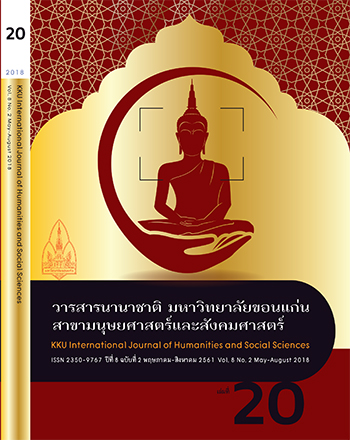Curriculum Leadership Development Model for the 21st Century of School Administrators under the Office of the Basic Education Commission
Main Article Content
Abstract
The research objectives were to 1) study and compare curriculum leadership behavior of 21st Century school administrators in the primary and secondary level, 2) analyze factors of the curriculum leadership model of school administrators for the 21st Century, and 3) present the curriculum leadership development model for the 21st Century of school administrators under the Office of the Basic Education Commission. The sample comprised 720 school administrators derived from multi-stage sampling. The collecting tools were 5-level rating scale questionnaire and case study form. The data analyses employed descriptive statistics, independent sample t-test, and referential statistics using LISREL software package together with content analysis. The research findings are as follow. (1) The curriculum leadership behavior in the 21st Century of the school administrators as a whole and in detailed dimension are at medium level. The behavior between the primary and secondary level school administrators has no difference. (2) Theoretical model of curriculum leadership factors for the 21st Century is congruent with empirical data with Chi-square (c2) equaling 4.58; degree of difference (df), 6; statistical significance (P-value), 0.60; goodness-of-fit index (GFI), 1.00; adjusted goodness-of-fit index, 0.99; and root-mean-square error (RMSE), 0.00. And (3) curriculum leadership development model for the 21st Century (The CLD Model) including 3 dimensions and 1 development mechanism.
Article Details
References
สัมฤทธิ์ กางเพ็ง และสรายุทธ กันหลง. (2560). การวิจัยแบบผสมวิธี: กระบวนทัศน์การวิจัยในศตวรรษที่ 21. พิมพ์ครั้งที่ 3. มหาสารคาม: อภิชาติการพิมพ์.
สัมฤทธิ์ กางเพ็ง. (2560). ภาวะผู้นำทางหลักสูตร: กลยุทธ์การพัฒนาและนำหลักสูตรไปใช้. มหาสารคาม: อภิชาติการพิมพ์.
Bradley, L.H. (2004). Curriculum Leadership: Beyond Boilerplate Standards. Lanham, ML: Scarecrow Education.
Brubaker, D.L. (2004). Creative Curriculum Leadership: Inspiring and Empowering Your School Community. 2nd ed. Thousand Oaks, CA: Corwin Press.
Campbell, S. & Samiec, E. (2005). 5-D Leadership : Key Dimensions for Leading in the Real World. Mountain View, CA : Davies-Black.
Chaleff, I. (2003). The Courageous Follower. 2nd ed. San Francisco, CA: Barrett-Koehler.
Creswell, J.W. (2015). A Concise Introduction to Mixed Methods Research. Thousand Oaks, CA: SAGE.
Day, V. D., Harrison, M. M., and Halpin, M. S. (2009). An Integrative Approach to Leader Development. New York, NY: Taylor and Francis Group.
DuBrin, A.J. (2010). Principles of Leadership. 6th ed. South-Western, Cengage Lerning.
English, F. and Steffy, B. (2005). Curriculum Leadership: The Administrative Survival Skill in a Test Driven Culture and Competitive Educational Marketplace. In F. English (Ed). The SAGE Handbook of Educational Leadership. (pp.407-429). Thousand Oaks, CA: SAGE.
Glatthorn, A.A., Jailall, J.M., and Jailall, J.K. (2017). The Principal as Curriculum Leader: Shaping What Is Taught and Tested. 4th ed. Thousand Oaks, CA: SAGE.
Harvard Business School. (2005). Power, Influence, and Persuasion: Sell Your Ideas and Make Things Happen. Harvard Business Essentials. (Editor). Boston: Harvard Business School Press.
Harvard Business School. (2006). The Essentials of Power, Influence, and Persuasion. Business Literacy for HR Professionals. (Editor). Boston : Harvard Business School Press.
Hemdemhall, M.E., Osland, J.S., Bird, A., Oddou, G.R., Maznevski, M.L., Stevens, M.J., and Stahl, G.K. (2013). Global Leadership: Research, Practice, and Development. 2nded. New York, NY: Routledge.
Kangpheng, S. & Kanlung, S. (2017). The Curriculum Leadership Model for the 21stCentury.
Law, E.H,F (2017). Developing Distributed Curriculum Leadership in Hong Kong Schools. New York, NY: Routledge.
Maxwell, J.C. (2011). The 5 Levels of Leadership: Proven Steps to Maximize Your Potential. 4th ed. New York, NY: Center Street.
Null, W. (2017). Curriculum: From Theory to Practice. 2nd ed. Lanham, ML: Rowman & Littlefield.
Parkay, F.W., Anctil, E.J., and Hass, G. (2014). Curriculum Leadership: Reading for Developing Quality Educational Programs. 10th ed. Upper Saddle River, NJ: Pearson Education.
Phillips, J.J. and Schmidt, L. (2004). The Leadership Scorecard. Burlington, MA: Elsevier Butterworth–Heinemann.
Phillips, J.J. and Schmidt, L. (2004). The Leadership Scorecard. Burlington, MA: Elsevier Butterworth–Heinemann.
Robin, R. (2014). Blended learning for leadership: The CCL Approach. Center for creative leadership white paper.
Skendall, K.C., Ostick, D.T., Komives, S.R., Wagner, W., and Associates. (2017). The Social Change Model: Facilitating Leadership Development. San Francisco, CA: Jossey-Bass.
Sorenson, R.D., Goldsmith, L.M., Mendez, Z.Y., and Maxwell, K.T. (2011). The Principal’s Guide to Curriculum Leadership. Thousand Oaks, CA: Corwin Press.
U.S. Department of Education. (2004). A Guide to Education and No Child Left Behind. Retrieved June 10, 2017, from https://www2.ed.gov/nclb/overview/intro/guide/guide.pdf.
Wiles, J. (2009). Developing Successful K-8 School: A Principal’s Guide . Thousand Oaks, CA: Corwin Press.
Wiles, W. J. (2011). Curriculum Development: A Guide to Practice. United States: Pearson.
Ylimaki, R.M. (2011). Critical Curriculum Leadership: A Framework for Progressive Education. New York, NY: Routledge.
Zemelman, S., and Ross, H. (2009). 13 Steps to Teacher Empowerment. Portsmouth, NH: Helmemann.

